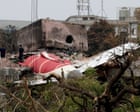
In a somber reflection on the Air India tragedy that claimed many lives, a preliminary report sheds light on the unfortunate incident involving flight AI171. The aircraft, carrying 242 passengers and bound for London, faced a catastrophic crash in the bustling city of Ahmedabad on June 12, marking a profound moment in aviation history as India’s deadliest air accident in nearly three decades.
The preliminary investigations provide crucial insights into the incident, pointing towards a sudden cessation of fuel supply to the engines shortly after takeoff. This vital detail comes from early findings that have been meticulously gathered and assessed by aviation safety experts. The resulting crash led to significant loss of life, including 19 individuals on the ground, and brought devastation to a densely populated residential area.
Conversations captured between the cockpit crew before the crash indicate discussions concerning the fuel control switches, though the content and context remain part of ongoing investigations. These exchanges may provide further understanding of what transpired in the final moments before the disaster.
Fostering a calm and comprehensive perspective, the investigation teams are dedicated to uncovering the sequence of events leading to the tragedy. By focusing on detailed analysis and thorough review, they aim to piece together the factors that contributed to the crash. This approach ensures that future preventative measures are guided by well-founded evidence, fostering trust in aviation safety protocols.
The impact of this incident reverberates through the aviation community and beyond, as colleagues and families grieve the immense loss. It also acts as a sober reminder of the inherent risks of air travel, underscoring the perpetual commitment to safety improvements and emergency preparedness.
As the investigation continues, authorities remain focused on understanding the full spectrum of contributing elements. The human stories intertwined with this event prompt a considerate and respectful handling of the aftermath, ensuring dignity for the victims and support for those affected by the accident.
This preliminary report serves as a cornerstone for comprehensive follow-up research that will delve deeper into the technologic, human, and environmental factors at play. Through ongoing collaboration with global aviation bodies, the aim is to reinforce operational standards and bolster safety for the future.
In the face of adversity, the resilience shown by the communities involved reflects a united front in addressing the challenges posed by such tragedies. This approach embodies a mindful and proactive stance, transforming grief into actionable steps towards healing and progress.
As the investigation unfolds, transparently and with due diligence, the global aviation industry remains committed to learning from such incidents, ensuring that the skies are safer for generations to come.
Source: {link}
